Get work done right, and right-on-time with our industry leading BPM platform.
Top 35 Resource Management Tools Every Team Needs
Resource management tools are essential for any business looking to allocate its resources effectively.
Finding a good tool is much easier said than done. There are tons of great ones out there dedicated to helping organizations allocate their recourses, plus many more that can be used for resource management while also aiding in other aspects of business.
But it’s up to each company’s leadership to decide which direction to go in that regard, but to help make deciding easier, we’ve put together a list of the top 35 resource management tools out there.
In this article, we’ll cover:
- Top 35 resource management tools
- What is resource management?
- Who needs resource management tools?
- Benefits of resource management tools
- Types of resource management tools
- Key features to look for in resource management tools
- Take advantage of the free things
Process Street

Process Street, known for its versatile checklist-based approach, can streamline resource management by creating templates for resource allocation, tracking, and optimization. It allows teams to create standardized processes for assigning resources, monitoring their usage, scheduling tasks, and ensuring efficient resource utilization, enhancing overall productivity and project success.
Key features:
- Checklist automation: Create and automate dynamic checklists for recurring processes.
- Conditional logic: Customize workflows with conditional logic based on responses.
- Collaborative workflows: Facilitate team collaboration on tasks and processes.
- Integration capabilities: Seamlessly integrate with tons of apps and tools.
- Task assignment: Assign and track responsibilities within processes.
- Data collection: Gather and store data through forms within checklists.
- Reporting and analytics tools: Generate insights with analytics on process performance.
- Version control: Maintain and track versions of checklists for auditing.
- API access: Connect with other applications through APIs.
- Document storage: Attach and manage documents relevant to processes.
Pros:
- Intuitive interface makes it user-friendly.
- Offers secure data handling and storage.
- It has a mobile application.
- Custom automated workflows can be made with AI.
- It has lots of premade workflow templates to choose from.
Cons:
- There is no free plan.
Hive

Hive excels in resource management by offering intuitive collaboration tools and project views that streamline resource allocation. It enables task assignment, scheduling, and tracking within a unified platform, facilitating clear resource visibility and optimizing team workflows. Hive’s integrations and reporting capabilities further enhance efficiency in resource planning and utilization.
Key features:
- Time off management: Track and manage employee leave and time-off requests.
- Project budgeting: Set and monitor project budgets, tracking expenses efficiently.
- Task dependencies: Set relationships between tasks for accurate scheduling.
- Mobile accessibility: Access Hive’s features and manage tasks on mobile devices.
- API access: Utilize the API to integrate and extend Hive’s functionality.
Pros:
- Connects with various third-party apps and services for extended functionality.
- Provides users with real-time chat and direct messaging for swift communication.
- Manages tasks visually and tracks progress through customizable Kanban boards.
- Utilizes pre-designed templates for quick project setup.
Cons:
- The reporting capabilities are limited.
- Setting up future actions is difficult.
nTask

nTask simplifies resource management by centralizing task assignment, scheduling, and tracking within a user-friendly platform. It allows teams to allocate resources efficiently, track workloads, set priorities, and manage dependencies. With reporting features and collaboration tools, nTask ensures streamlined resource utilization for enhanced project efficiency and successful outcomes.
Key features:
- Task management: Create, assign, and organize tasks efficiently within projects or teams.
- To-do lists: Compile lists of tasks or actions needed, categorizing them by priority or due dates.
- Time tracking: Monitor time spent on tasks and projects, aiding in productivity analysis.
- Gantt charts: Visualize project timelines, dependencies, and progress.
- Team collaboration: Facilitate communication and cooperation among team members.
Pros:
- Assess and mitigate potential risks associated with projects, enhancing overall project success rates.
- Manage project expenses and budgets, monitoring costs for better financial control.
- Efficiently allocate and manage resources across different projects.
- Set task priorities to focus on critical activities and ensure timely completion.
Cons:
- It isn’t the most intuitive.
- It can be difficult to locate certain features.
Smartsheet
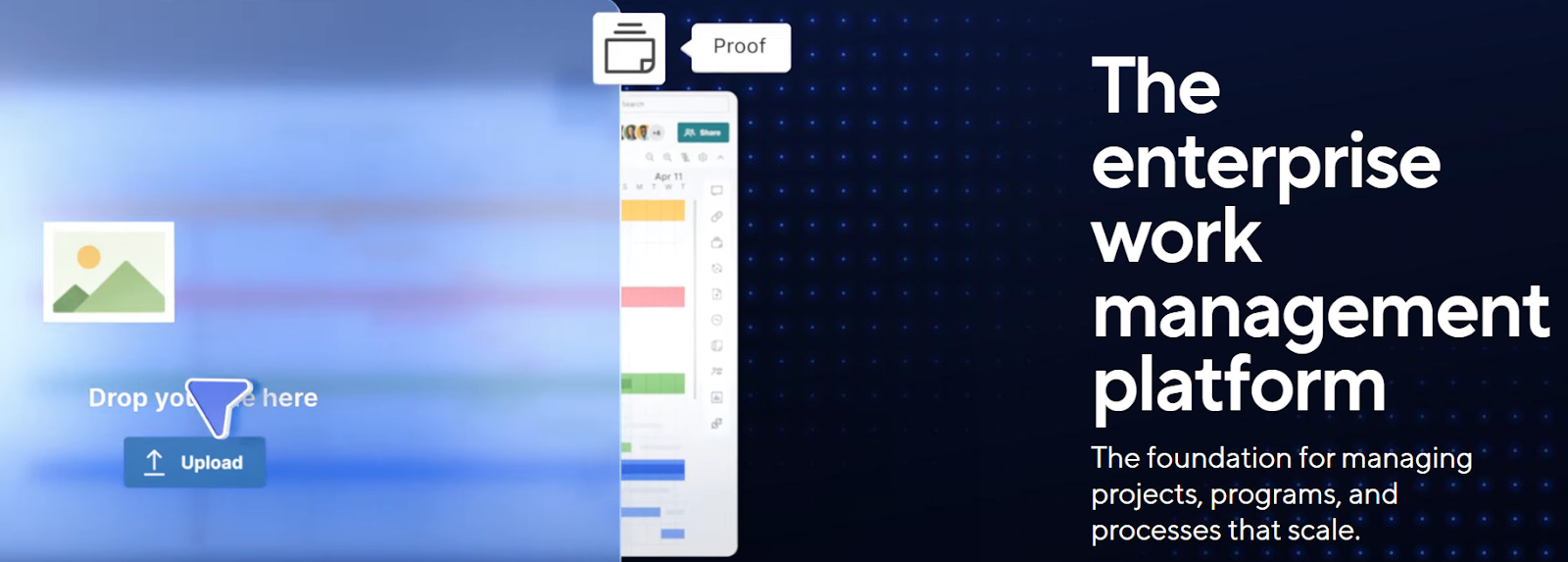
Smartsheet serves as a dynamic work and resource management platform, combining the familiarity of a spreadsheet interface with robust project management capabilities. It empowers teams to collaborate, organize, and execute projects efficiently. Known for its versatility, Smartsheet adapts to diverse workflows, enhancing productivity and fostering seamless coordination among teams.
Key features:
- Spreadsheet interface: Familiar interface for ease of use.
- Gantt charts: Visualize project timelines and dependencies.
- Forms: Create forms for data collection and entry.
- Resource management: Allocate resources and manage workloads.
- Project templates: Pre-built templates for various project types.
Pros:
- Adaptable for various project management and task tracking needs.
- Generates customizable reports for project insights.
- Provides controls for data access and permissions.
- Seamless integration with multiple third-party apps and services.
Cons:
- It doesn’t have native communication tools; instead, it relies on integrations for comprehensive communication features.
- It doesn’t work well for smaller-scale projects.
Katana (formerly Mavenlink)

Katana supports manufacturers and crafters with its intuitive manufacturing and inventory management tools. Renowned for its scalability, it optimizes production processes, streamlines workflows, and offers real-time insights. With a focus on craft industries, Katana simplifies operations, fostering growth and efficiency seamlessly.
Key features:
- Production planning: Efficient planning and scheduling of production activities.
- Order fulfillment: Streamlines order processing and fulfillment.
- Bill of materials (BOM): Creation and management of bill of materials.
- Real-time inventory updates: Provides real-time updates on inventory levels.
- Multi-channel sales: Integrates with various sales channels and platforms.
Pros:
- Enables barcode scanning for inventory tracking.
- Manages purchasing and supplier relationships.
- Provides insights into production and sales data.
- Integrates with various accounting and e-commerce platforms.
Cons:
- Pricing might be a concern for some smaller businesses.
- Might not cater comprehensively to industries outside manufacturing and craft sectors.
Paymo

Paymo offers a streamlined project management solution, emphasizing efficiency and collaboration. It’s a versatile platform fostering productivity through task organization and team coordination. With an intuitive interface and diverse functionalities, it empowers users to navigate projects seamlessly, optimize workflows, and achieve project milestones effortlessly.
Key features:
- Project templates: Utilize pre-designed templates for quick project setup.
- Invoicing: Create and send invoices based on tracked time and expenses.
- Expense tracking: Monitor project-related expenses and manage budgets effectively.
- Gantt charts: Visualize project timelines and dependencies for comprehensive planning.
- Resource scheduling: Allocate resources and manage team availability for tasks.
Pros:
- Shares project progress and collaborates with clients through a dedicated portal.
- Sets and monitors project budgets, tracking expenses and profits.
- Establishes task relationships for accurate project scheduling.
Cons:
- Users have said that it buffers a lot.
Monday.com

Monday.com is a dynamic work operating system designed to streamline collaboration and project management. It provides a visual and customizable platform for teams to manage tasks, projects, and workflows efficiently. Monday.com helps teams enhance communication and productivity while adapting to diverse work processes.
Key features:
- Workspaces: Create customized workspaces for different projects.
- Boards: Visualize tasks and projects through customizable boards.
- Pulses: Individual task cards with detailed information.
- Timeline view: Display project timelines for better planning.
- Automations: Streamline workflows with automated actions.
Pros:
- Attach and share files directly within the platform.
- Real-time collaboration with team members.
- Create and customize visual dashboards for insights.
- Responsive customer support for assistance.
Cons:
- The free plan has very limited features.
- It doesn’t offer an offline mode.
Airtable

Airtable combines the flexibility of spreadsheets with the power of databases, making it a versatile tool for tracking tasks, projects, resources, and product development workflows. Airtable offers customization and collaboration, streamlining data management in product management processes.
Key features:
- Spreadsheets: Organized project information in customizable spreadsheets.
- Kanban boards: Assign project tasks with Kanban boards.
- Approval process control: Create approval processes for quality control
- Data storage management: Store and retrieve project data securely.
Pros:
- It has lots of premade templates.
- Very affordable.
- Its spreadsheets have a lot of features and capabilities.
Cons:
- Spreadsheets don’t allow long sentences.
ClickUp
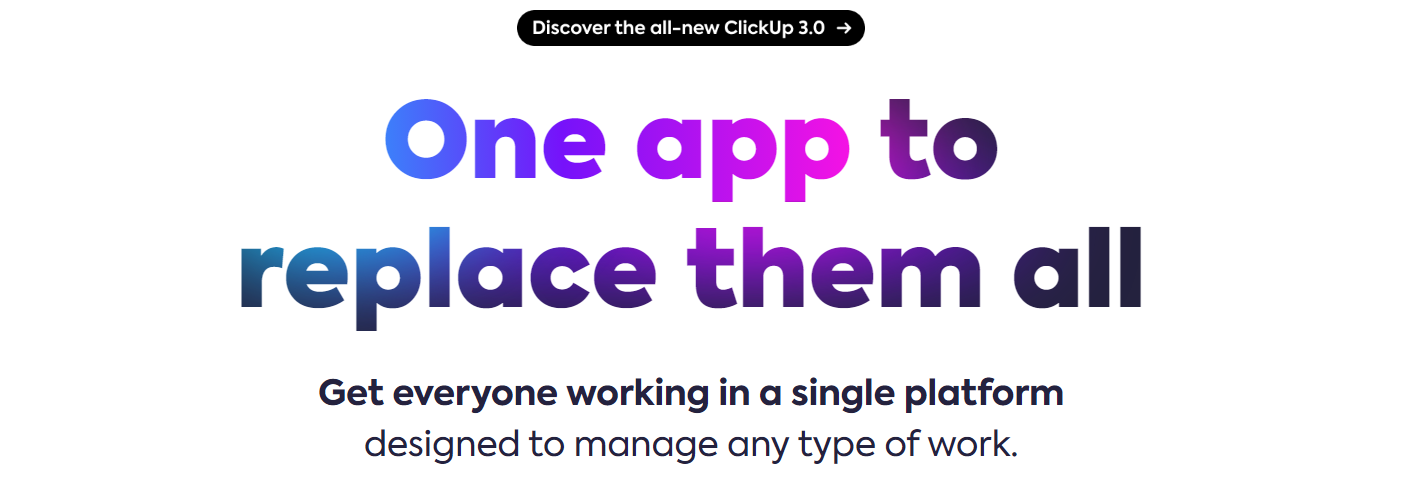
ClickUp offers robust resource management through customizable views, enabling teams to allocate, track, and optimize resources effectively. With task dependencies, workload management, and time tracking features, it allows precise resource allocation.
Key features:
- Multiple views: Kanban boards, lists, calendars, and Gantt charts for varied project perspectives.
- Time tracking: Monitor time spent on tasks and projects.
- Team collaboration: Comments, mentions, and real-time collaboration on tasks.
- Goals and OKRs: Set and track objectives and key results.
- Document management: File storage, document editing, and version control.
Pros:
- Offers a wide range of features catering to diverse project management needs.
- Allows for the creation of automated workflows, enhancing efficiency.
- Offers a free plan ideal freelancers and small businesses.
Cons:
- Users have reported occasional lags or performance issues, especially with large data sets.
TeamGantt
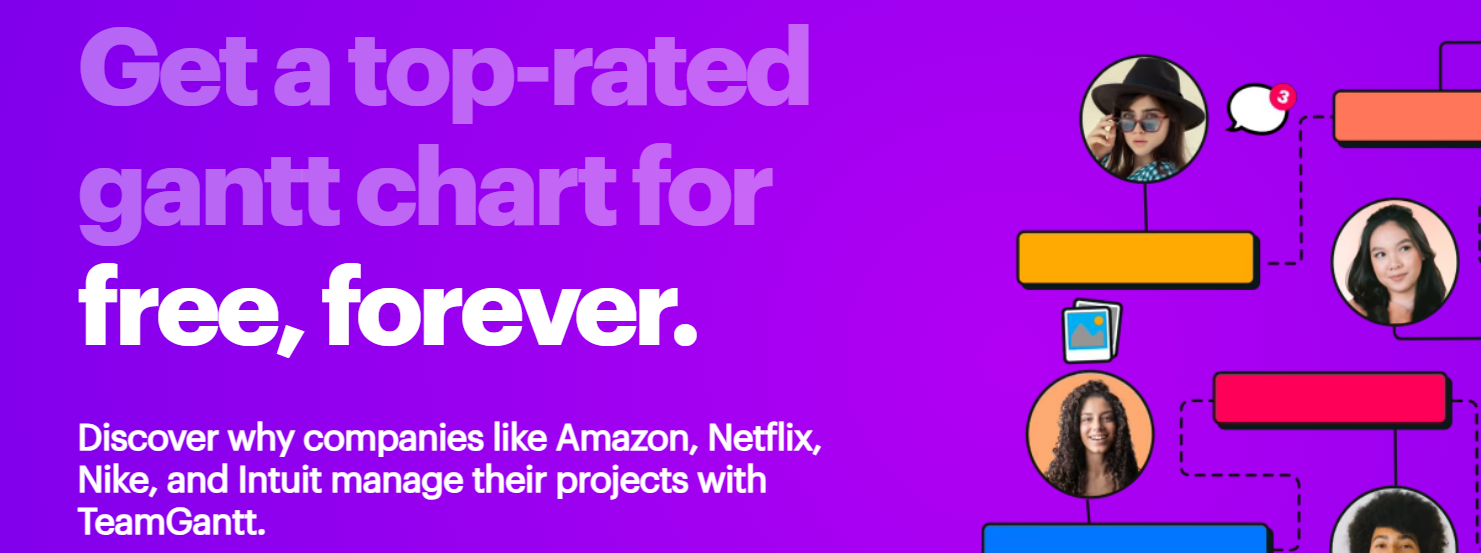
TeamGantt offers intuitive project planning, simplifying complex tasks through visual timelines. It facilitates collaborative scheduling and task delegation, promoting team alignment. Prioritizing clarity and accessibility, it empowers users to create, share, and execute detailed project plans efficiently, fostering productivity and successful project management.
Key features:
- Gantt charts: Visualize project timelines and dependencies effortlessly.
- Drag-and-drop: Easily rearrange tasks within the Gantt chart interface.
- Collaborative planning: Invite team members to collaborate on project planning.
- Task dependencies: Set task relationships and dependencies for accurate scheduling.
- Milestone tracking: Mark key project milestones for progress monitoring.
Pros:
- Tailors Gantt charts to display information according to preferences.
- Compares actual project progress against initial plans.
- Monitors and balances workloads across the team.
- Allocates resources and team members to specific tasks.
Cons:
- There aren’t many options for custom visualization.
- The free versions lacks some of the more advanced features.
Wrike

Wrike is a robust project management methodology and collaboration platform designed to streamline workflows and enhance team productivity. Its dynamic interface and flexible structure cater to diverse project needs, fostering efficient communication and project coordination. Wrike empowers teams to manage tasks, projects, and resources seamlessly for successful project outcomes.
Key features:
- Time tracking: Monitor and analyze time spent on tasks and projects.
- Resource management: Allocate and manage team resources effectively.
- Task management: Organize and prioritize tasks efficiently.
- Project planning: Plan and visualize projects with timelines and Gantt charts.
- Collaboration: Facilitate real-time collaboration and communication.
Pros:
- Efficient allocation and management of team resources.
- Convenient file sharing and collaboration within the platform.
- Adaptable to various project management needs.
- Seamless third-party integrations with numerous apps.
Cons:
- Basic features in the free plan may be insufficient for larger teams.
- Can be resource-intensive in terms of memory and processing.
Zoho Project

Zoho Projects stands as a comprehensive project management solution, seamlessly uniting teams through its intuitive interface. It empowers collaboration, streamlines workflows, and facilitates task organization. Offering a holistic approach, Zoho Projects fosters efficient project execution and cohesive team coordination.
Key features:
- Time tracking: Monitor time spent on tasks and projects.
- Milestone tracking: Set and achieve project milestones.
- Resource allocation: Allocate resources and manage workloads.
- Issue tracking: Track and manage project issues or bugs.
- Budgeting: Manage project budgets and expenses.
Pros:
- Visualizes project timelines and dependencies.
- Assigns tasks, sets deadlines, and tracks progress.
- Offers competitive pricing plans suitable for different team sizes and needs.
- Offers a wide array of project management features in one platform.
Cons:
- Advanced customization might be restricted in certain areas.
- Some features might require time for users to fully understand and utilize effectively.
Harvest

Harvest is a robust time tracking and invoicing tool that empowers users to efficiently manage projects and billable hours. With an intuitive interface, it meticulously tracks time, aiding project insights and invoicing accuracy. Beyond tracking, Harvest streamlines operations, fostering productivity and financial management effortlessly for businesses and freelancers.
Key features:
- Time tracking: Accurate tracking of billable hours and tasks.
- Expense tracking: Monitoring and managing project expenses.
- Invoicing: Creating and sending professional invoices to clients.
- Client portal: Providing clients access to project-related information and invoices.
- Timesheet approval: Review and approve timesheets for accuracy.
Pros:
- Organizes and tracks project progress and tasks.
- Assigns tasks and tracks team members’ time.
- Offers detailed insights into project budgets, time spent, and profitability.
Cons:
- Some users find the interface overwhelming initially.
- There is no built-in CRM.
eResource Scheduler

eResource Scheduler serves as a dynamic resource management tool catering to diverse industries. It optimizes resource allocation, balancing workloads efficiently. Its user-friendly interface facilitates scheduling and enhances team collaboration, ensuring optimal resource utilization. eResource Scheduler fosters streamlined operations, promoting productivity and project success across organizations.
Key features:
- Resource scheduling: Efficiently schedules resources for projects.
- Workload balancing: Ensures balanced workloads among team members.
- Shift planning: Plans and manages employee shifts efficiently.
- Cost management: Tracks costs associated with resource allocation.
- Task dependencies: Manages task dependencies for efficient scheduling.
Pros:
- Facilitates communication and collaboration among teams.
- Monitors resource availability and utilization.
- Tracks time spent on tasks and projects.
- Manages employee leave and availability.
Cons:
- It doesn’t support invoicing.
- There is no Salesforce integration.
Float

Float revolutionizes resource management by offering intuitive scheduling and forecasting tools. It optimizes team productivity through smart allocation, providing clarity on resource availability and project timelines. It fosters efficient resource utilization, empowering teams to deliver projects seamlessly and on schedule.
Key features:
- Intuitive scheduling: Effortless resource scheduling and planning.
- Resource forecasting: Predicts resource availability for future projects.
- Forecast accuracy: Provides accurate predictions for resource availability.
- Project dependencies: Manages dependencies for efficient scheduling.
Pros:
- Tracks changes made to resource schedules.
- Maps resources to specific clients or projects.
- Estimates effort required for tasks or projects.
Cons:
- It doesn’t offer any financial projections.
Adobe Workfront

Adobe Workfront provides a comprehensive platform for seamless resource management. It unifies teams, streamlines workflows, and enhances project visibility, fostering efficiency and alignment across organizations. Workfront’s intuitive interface and robust tools empower teams to innovate, execute tasks, and achieve impactful results efficiently.
Key features:
- Request management: Manages incoming requests and aligns them with workflows.
- Proofing and review: Streamlines the review and approval process for assets.
- Portfolio management: Manages and tracks portfolios of projects and initiatives.
- Resource forecasting: Predicts resource needs for upcoming projects.
- Budgeting and cost management: Tracks project costs and budgets.
Pros:
- Offers a personalized homepage providing a unified view of work.
- Adapts to agile project management practices.
- Facilitates data synchronization across systems and tools.
- Tracks changes and maintains version history for compliance.
Cons:
- It’s really only suitable for large enterprises.
- The client portal can be difficult to understand.
Deskera

Deskera redefines business management with its unified platform, integrating ERP, CRM, HR, and project management. It empowers businesses with a scalable, cloud-based solution, simplifying operations and fostering growth. Deskera’s intuitive interface and comprehensive suite enhance productivity, enabling streamlined processes across finance, sales, HR, and operations.
Key features:
- Enterprise resource planning (ERP): Centralizes core business processes like finance, inventory, and procurement.
- Customer relationship management (CRM): Manages customer interactions and sales pipelines.
- Human resource management (HRM): Streamlines HR processes including payroll, leave, and attendance.
- Project management: Organizes and tracks project progress and tasks.
- Inventory management: Manages stock levels and inventory across locations.
Pros:
- Tracks financial transactions and generates reports.
- Manages the flow of goods and services.
- Tracks sales orders and fulfillment processes.
- Manages purchase orders and vendor interactions.
Cons:
- Bank integrations don’t work well.
- It isn’t well-suited for large enterprises.
Saviom
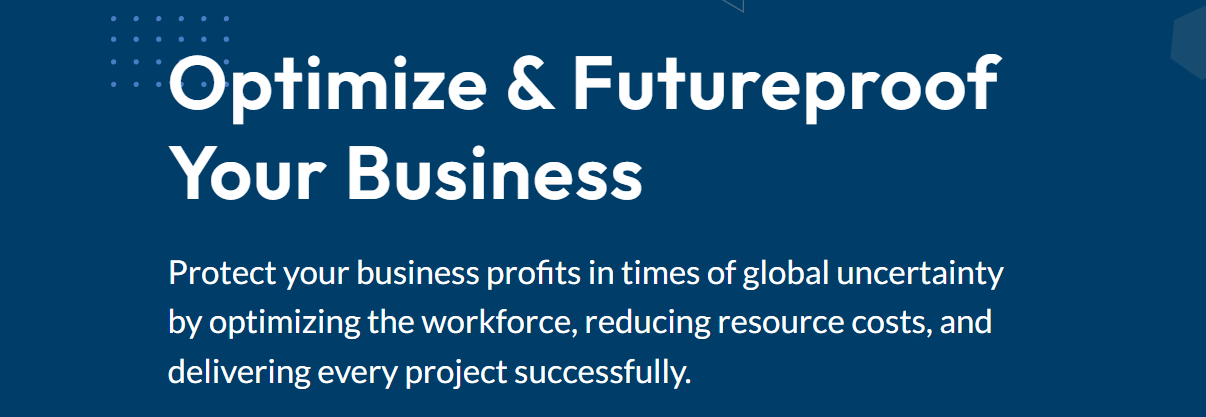
Saviom stands as a leading resource management solution, optimizing workforce efficiency and project delivery. It offers a robust platform focusing on resource allocation, capacity planning, and skills management.
Key features:
- Capacity planning: Forecasts resource needs based on project requirements.
- Skills management: Tracks and manages employee skill sets for better resource allocation.
- Project scheduling: Plans and schedules tasks and projects.
- Timesheet management: Tracks and records employee working hours.
- Budgeting and financial reports: Manages project budgets and expenses.
Pros:
- Measures and analyzes resource utilization.
- Assigns tasks to team members based on skill and availability.
- Offers a calendar views of project schedules and resource availability.
- Manages multiple projects within a portfolio.
Cons:
- It has occasional network instability.
- The UI is old-fashioned, which makes it less intuitive.
ControlHippo

ControlHippo offers robust incident management solutions, focusing on incident reporting, tracking, and resolution. Its emphasis on streamlined workflows and compliance ensures effective incident response.
Key features:
- Incident reporting: Enables users to report incidents easily.
- Incident tracking: Tracks incidents through their lifecycle.
- Workflow automation: Automates incident resolution processes.
- Customizable incident forms: Allows customization of incident reporting forms.
- Root cause analysis: Investigates the underlying causes of incidents.
Pros:
- Ensures adherence to regulatory standards.
- Prioritizes incidents based on severity.
- Tracks the progress of incident resolution.
- Manages access based on user roles.
Cons:
- There is no free version.
- It is not specifically designed for resource management so it is missing some features of products that are.
Runn
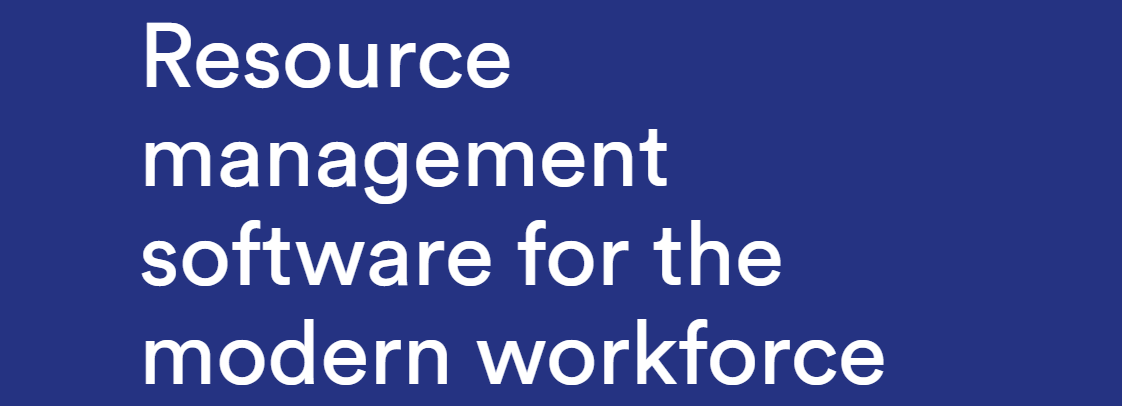
Runn streamlines resource planning, offering a comprehensive platform for project management. It specializes in resource allocation, forecasting, and budgeting, aiding in project delivery optimization. It facilitates better decision-making, enabling teams to manage resources efficiently and drive project success seamlessly.
Key features:
- Capacity planning: Forecasts resource availability based on workload.
- Time tracking: Records and manages work hours spent on tasks.
- Project dashboard: Provides an overview of project progress and status.
- Scenario planning: Models different project scenarios for analysis.
- Resource utilization analytics: Measures and optimizes resource utilization.
Pros:
- Generates reports on project financials and costs.
- Streamlines timesheet approval processes.
- Manages and allocates resources from a centralized pool.
- Forecasts project budgets and expenses.
Cons:
- Permission levels can be limited.
- It doesn’t offer many integrations compared to other similar products.
Forecast

Forecast redefines project and resource management with its AI-powered platform. It focuses on predictive analytics, optimizing resource allocation, and project delivery. It empowers teams to forecast project success, streamline operations, and drive productivity, fostering seamless project execution and growth.
Key features:
- Forecast accuracy metrics: Provides metrics to evaluate the accuracy of predictions.
- Risk and issue management: Identifies and manages project risks and issues.
- Automated reminders: Sends alerts and reminders for upcoming deadlines.
- Budget forecasting: Forecasts project budgets and expenses.
- Resource pooling: Manages and allocates resources from a centralized pool.
Pros:
- Assigns and manages resources for projects.
- Plans and schedules project timelines and milestones.
- Records and manages work hours for accurate billing and reporting.
- Manages project expenses and budgets.
Cons:
- There is no mobile app.
- They use aggressive upselling.
Teamdeck

Teamdeck offers a comprehensive resource management platform empowering teams to efficiently handle resources, time, and projects. With insightful analytics, Teamdeck facilitates informed decisions, optimizing workflows for enhanced team performance and successful project outcomes.
Key features:
- Task management: Organizes and tracks project tasks and deadlines.
- Availability calendar: Displays resource availability for scheduling.
- Skill-based allocation: Considers skills when assigning resources.
- Team collaboration: Facilitates communication and collaboration among team members.
- Vacation and leave management: Tracks and manages employee leave and availability.
Pros:
- Generates reports for project progress and insights.
- Streamlines timesheet approval processes.
- Predicts resource needs for future projects.
- Identifies and resolves resource conflicts.
Cons:
- It sometimes shows incorrect data in reports.
- It occasionally lags.
Mosaic

Mosaic resource management streamlines talent strategies with data-driven insights. It optimizes workforce planning, aligning skills and roles for business goals. By fostering collaboration and growth, Mosaic enhances organizational performance, empowering teams with the right skills at the right time, ensuring sustained success and innovation.
Key features:
- Strategic workforce planning: Aligns talent strategy with business objectives.
- Skills mapping: Identifies and maps employee skills for role alignment.
- Succession planning: Identifies and grooms future leaders within the organization.
- Performance management: Tracks and manages employee performance.
- Resource allocation: Efficiently assigns resources to projects or tasks.
Pros:
- Segments the workforce for targeted strategies.
- Assists in managing organizational changes.
- Adapts plans to change business needs and scenarios.
- Provides tools for managing remote teams effectively.
Cons:
- Timesheets experience occasional bugs.
- Completed tasks disappear before they can be reviewed.
Resource Guru

Resource Guru is as a versatile resource scheduling solution, focusing on streamlined team coordination. It centralizes resource management, aiding in optimized project allocation and team availability tracking. It simplifies scheduling complexities, enabling teams to efficiently manage resources and enhance project delivery, thus fostering organizational success.
Key features:
- Resource allocation: Assigns and manages resources for projects.
- Team scheduling: Organizes and schedules team members’ work.
- Real-time availability: Tracks resource availability for scheduling.
- Project planning: Plans and schedules project timelines and tasks.
- Skill-based scheduling: Considers skills when assigning resources.
Pros:
- Offers a visual calendar representation of schedules.
- Manages access levels based on user roles.
- Manages and allocates resources from a centralized pool.
- Manages resources across multiple projects.
Cons:
- There are limited data filters.
Hub Planner

Hub Planner offers a dynamic resource management solution, focusing on streamlined scheduling and resource allocation. It centralizes project planning and team coordination, optimizing resource utilization. It empowers teams to efficiently manage resources and schedules, ensuring successful project outcomes through enhanced collaboration and planning.
Key features:
- Conflict resolution: Identifies and resolves scheduling conflicts.
- Resource pooling: Manages and allocates resources from a centralized pool.
- Client or stakeholder collaboration: Engages clients or stakeholders in project collaboration.
- Holiday and time-off tracking: Tracks holidays and time-off schedules.
- Visual resource utilization metrics: Provides visual metrics for resource usage.
Pros:
- Assigns and manages resources for projects and tasks.
- Plans and schedules project timelines and milestones.
- Considers skills when assigning resources.
- Predicts resource needs for future projects.
Cons:
- Users have complained about an oversaturation of features, many of which aren’t useful.
LiquidPlanner

LiquidPlanner excels in project management, embracing dynamic scheduling and collaborative workflows. It emphasizes realistic project timelines, adaptive planning, and team collaboration. Its smart, intuitive platform adapts to changes, enabling teams to prioritize tasks effectively.
Key features:
- Dynamic scheduling: Adapts project plans to changes in real-time.
- Priority-based planning: Prioritizes tasks based on importance.
- Resource management: Assigns and tracks resource allocation.
- Progress tracking: Monitors and updates task progress.
- Automatic deadline adjustments: Adapts schedules based on task changes.
Pros:
- Organizes tasks based on criteria for better management.
- Sends alerts and updates via email.
- Involves clients in project discussions and updates.
- Adapts project plans to changes in real-time.
Cons:
- It doesn’t work well for organizations with large numbers of projects and resources.
- It can be difficult for clients to learn how to use.
Meisterplan

Meisterplan redefines project portfolio management with a focus on strategic planning and portfolio optimization. It empowers organizations to align resources with business goals, fostering efficient project execution. Its emphasis on transparency and data-driven decisions enables agile planning, ensuring optimal resource utilization and successful project delivery.
Key features:
- Resource allocation: Assigns and manages resources for projects.
- Project portfolio planning: Plans and prioritizes project portfolios.
- Scenario planning: Models different project scenarios for analysis.
- Resource capacity planning: Forecasts resource availability and needs.
- Portfolio optimization: Optimizes project portfolios based on objectives.
Pros:
- Manages project expenses and budgets.
- Measures project success and performance.
- Aligns portfolios with organizational goals.
- Adapts plans to changing business needs and scenarios.
Cons:
- It takes a while to implement, especially with larger teams.
Timewax

Timewax revolutionizes project planning and resource management with a user-centric approach. It emphasizes streamlined scheduling and optimal resource allocation, fostering efficient project execution.
Key features:
- Gantt chart view: Provides a visual representation of project timelines.
- Resource allocation: Optimizes resource utilization for projects.
- Budgeting and cost management: Manages project expenses and budgets.
- Team collaboration: Facilitates team communication and coordination.
- Timesheet management: Tracks and records employee work hours.
Pros:
- Tracks and manages employee leave and availability.
- Manages different cost rates for resources.
- Engages clients in project discussions and updates.
Cons:
- There is no free version.
InLoox

InLoox is a project management platform fostering seamless collaboration and efficiency. It integrates seamlessly with Microsoft Outlook, prioritizing user convenience. Its emphasis on intuitive interfaces and robust functionalities enables teams to streamline project planning, task management, and resource allocation, ensuring project success and optimized workflows.
Key features:
- Client collaboration: Involves clients in project discussions and updates.
- Risk management: Identifies and manages project risks.
- Calendar view: Offers a calendar-based view of project schedules.
- Timesheet management: Tracks and records employee work hours.
- Issue tracking: Manages and tracks project-related issues.
Pros:
- Organizes and tracks project tasks and deadlines.
- Assigns and manages resources for projects.
- Facilitates team communication and collaboration.
- Stores and shares project-related files and documents.
Cons:
- They don’t offer any risk management features.
- It’s no good for freelancers.
Ganttic

Ganttic redefines resource planning with its intuitive and flexible platform. It emphasizes visual scheduling, enabling teams to manage resources, projects, and tasks efficiently. With its drag-and-drop simplicity and customizable views, Ganttic empowers dynamic planning, fostering collaboration and ensuring optimized resource utilization for successful project outcomes.
Key features:
- Resource scheduling: Assigns and manages resources for projects.
- Visual scheduling: Provides a visual representation of schedules and timelines.
- Drag-and-drop interface: Simplifies resource allocation and scheduling.
- Gantt chart view: Visualizes project timelines and dependencies.
- Resource utilization tracking: Monitors and optimizes resource usage.
Pros:
- Sends alerts and reminders for tasks or schedules.
- Manages project expenses and budgets.
- Manages multiple projects within a portfolio.
- Models different scheduling scenarios for analysis.
Cons:
- Users can’t make private document drafts.
- Users have reported trouble accessing the mobile app.
GanttPRO

GanttPRO streamlines project planning with its intuitive Gantt charts, focusing on visual clarity and team collaboration. It centralizes tasks, timelines, and resource allocation, enabling agile project management.
Key features:
- Interactive Gantt charts: Visualizes project timelines and tasks.
- Task dependencies: Manages relationships and dependencies between tasks.
- Resource management: Allocates and manages resources for projects.
- File attachment: Attaches and shares project-related documents.
- Risk management: Identifies and manages project risks.
Pros:
- Allows flexibility in data and task organization.
- Generates reports for project progress and analytics.
- Monitors and updates task completion status.
Cons:
- Sometimes task parameters don’t save.
Silverbucket
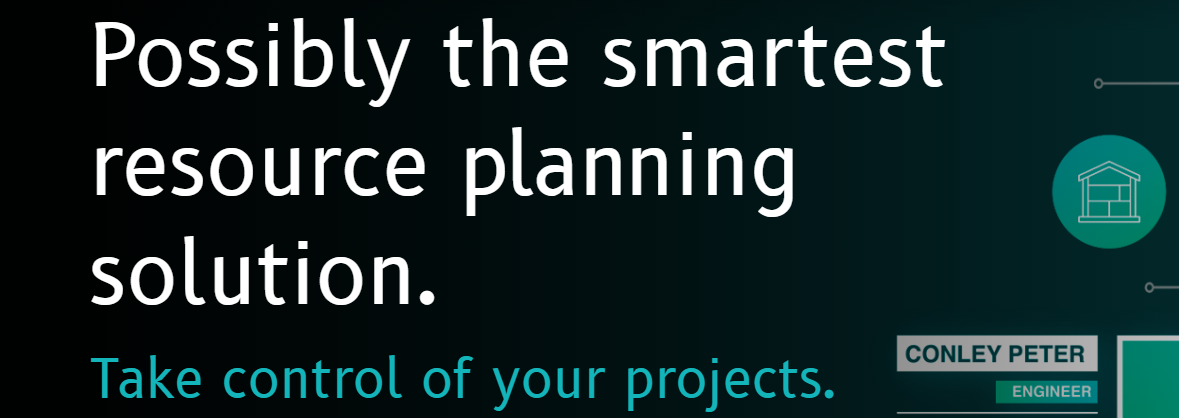
Silverbucket excels in resource management, focusing on efficient allocation and capacity planning. It centralizes resource data, optimizing workforce allocation for projects. With its intuitive interface and insightful analytics, Silverbucket empowers agile decision-making, ensuring teams have the right skills and resources for successful project execution and growth.
Key features:
- Resource allocation: Assigns and manages resources for projects.
- Capacity planning: Forecasts and optimizes resource capacity.
- Skills mapping: Matches resources based on skillsets.
- Project portfolio management: Manages multiple projects within a portfolio.
- Resource utilization analytics: Measures and optimizes resource usage.
Pros:
- Predicts resource needs for future projects.
- Identifies gaps in resource skills versus project needs.
- Identifies and resolves resource allocation conflicts.
- Measures the accuracy of resource predictions.
Cons:
- Its resource requesting abilities are limited.
Scoro
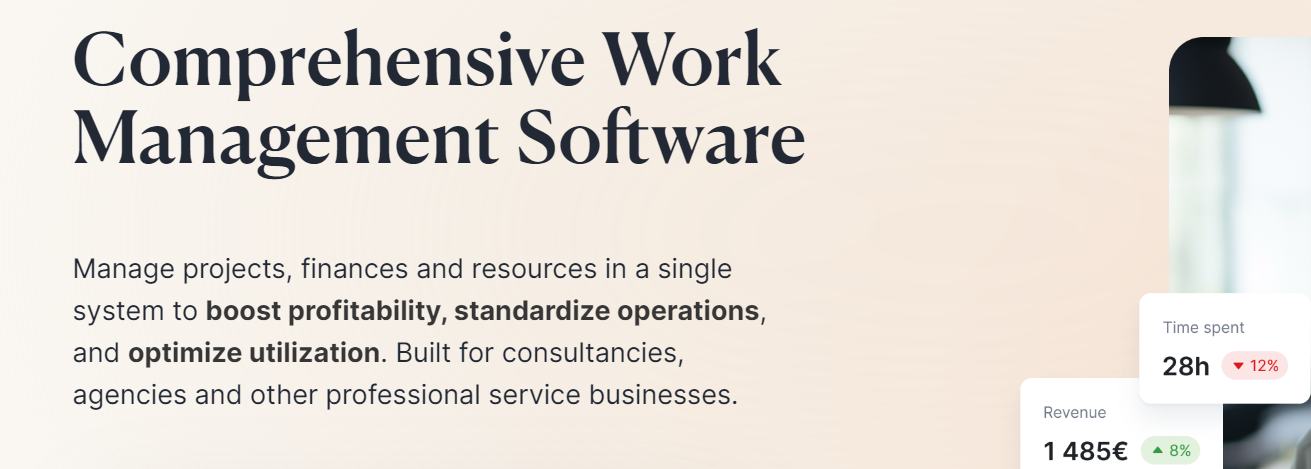
Scoro stands as a comprehensive business management solution, merging project and financial management with CRM and billing. It unifies processes, providing a centralized platform for teams. With its customizable dashboards and automation, Scoro streamlines workflows, empowering businesses to drive productivity and make informed decisions for sustained growth and success.
Key features:
- Financial management: Manages invoices, budgets, and expenses.
- CRM integration: Manages customer relationships and interactions.
- Billing and invoicing: Generates invoices and tracks payments.
- Resource planning: Allocates and manages resources for projects.
Pros:
- Integrates with email for communication and updates.
- Tracks and manages inventory levels.
- Sets and tracks organizational or project goals.
Cons:
- Not suitable for freelancers or large enterprises.
What is resource management?
Resource management is the strategic and efficient allocation and utilization of an organization’s resources to achieve its goals and objectives. These resources may include physical assets, such as equipment and facilities, as well as human capital, financial resources, and information technology. Resource management involves planning, organizing, and controlling these resources in a way that maximizes their value and minimizes waste.
Effective resource management is essential for organizations to remain competitive and sustainable in today’s rapidly changing business environment. It allows businesses to optimize their operations, improve productivity, and reduce costs. By allocating resources in the most efficient way, organizations can also ensure that they have the necessary resources to respond to market fluctuations and changing customer demands.
In addition to optimizing resource allocation, resource management also involves managing the risks and uncertainties associated with resource utilization. This may include developing contingency plans for potential resource shortages, monitoring resource usage to identify areas of inefficiency, and implementing strategies to mitigate risks.
Resource management is not limited to traditional business organizations. It is also an essential practice in project management, where the effective allocation of time, budget, and labor are critical to the success of any given project. In this context, resource management involves identifying the necessary resources for a project, estimating their costs and availability, and creating a plan for their utilization throughout the project’s lifecycle.
Who needs resource management tools?
Resource management tools are essential for anyone who needs to effectively manage their resources and improve their overall productivity. Whether you are a business owner, project manager, or individual looking to optimize your time and resources, these tools can help you streamline your operations and accomplish your goals more efficiently.
For business owners, resource management tools are vital for maximizing the utilization of their assets, including personnel, equipment, and finances. By using these tools, business owners can track and allocate resources more effectively, leading to increased operational efficiency and ultimately higher profits. Additionally, these tools can help business owners identify any resource inefficiencies and make necessary adjustments to improve their overall performance.
Project managers can also benefit greatly from resource management tools as they are tasked with overseeing and coordinating various project resources, such as labor, materials, and budgets. These tools can assist in resource planning, scheduling, and allocation, allowing project managers to stay on top of their projects and ensure that all resources are being used effectively to meet project deadlines and objectives.
Individuals, whether freelancers or students, can also benefit from resource management tools to better organize their time, tasks, and responsibilities. By utilizing these tools, individuals can create schedules, set priorities, and track their progress, leading to improved time management and productivity.
Benefits of resource management tools
Resource management software provides significant benefits for organizations in efficiently and effectively utilizing their valuable resources. Some key benefits of using resource management tools include:
Optimal resource allocation
Resource planning tools enable organizations to allocate resources effectively by identifying available resources, their capacity, and the demands of different projects or tasks. This helps in avoiding overallocation or underutilization of resources, leading to better productivity and cost savings.
Improved planning and scheduling
With resource management tools, organizations can create and manage detailed plans and schedules for projects, tasks, and resource assignments. This ensures that projects are completed on time and within budget by streamlining the planning process and avoiding conflicts in resource assignments.
Real-time visibility
Resource management tools provide real-time visibility into resource allocation and availability, enabling resource managers to make informed decisions and quickly address any resource shortages or conflicts. This helps in avoiding project delays and disruptions.
Enhanced collaboration
These tools facilitate collaboration among teams by providing a centralized platform to communicate, share information, and coordinate resource allocation. This fosters better teamwork and ensures that everyone is on the same page regarding resource utilization.
Performance optimization
By effectively managing resources, organizations can optimize their performance and deliver high-quality results within the set timelines. This can lead to improved customer satisfaction and better overall business outcomes.
Types of resource management tools
Types of resource management tools include:
Project management software
Project management tools help to plan, organize, and manage resources such as project teams, equipment, and time for specific projects.
Resource scheduling software
Resource schedulers help in scheduling and allocating resources efficiently, maximizing utilization and minimizing conflicts.
Resource allocation software
These tools help in the allocation of resources to different projects or tasks, ensuring that resources are used effectively and efficiently.
Time tracking software
Time tracking tools help in tracking the time spent by employees on different tasks and projects, allowing for better resource management and productivity.
Resource planning software
This type of tool helps in forecasting and planning resource requirements for future projects, allowing for better resource allocation and utilization.
Resource optimization software
These tools help in optimizing the use of resources, identifying areas for improvement and maximizing the productivity of resources.
Key features to look for in a resource management tool
Common features to look for in a resource management tool include:
Resource scheduling
The ability to schedule and allocate resources to specific projects or tasks, ensuring that the right resources are available at the right time.
Capacity planning
The tool should allow for the assessment of resource availability and capability, helping to avoid over- or under-allocating resources.
Time tracking
Time trackers give users the ability to track the actual time spent by resources on different tasks or projects, helping to monitor and optimize resource utilization.
Reporting and analytics
A good resource management tool should offer robust reporting and analytics capabilities to provide insights into resource utilization and performance.
Collaboration and communication
Features that facilitate communication and collaboration among team members and stakeholders, helping to streamline resource allocation and improve overall productivity.
Integration with other tools
The ability to integrate with other project management or productivity tools, ensuring seamless data flow and coordination across different platforms.
Customization and scalability
The tool should be customizable to fit the specific needs of the organization and scalable to accommodate growth and changes in resource management requirements.
Take advantage of the free things
Just about every single one of the tools on this list offers something for free. A free trial, a free demo, a free plan, you name it. Take advantage of all of it! Use them as a way to help you find the best tools for your business so it can thrive.
Happy shopping!







